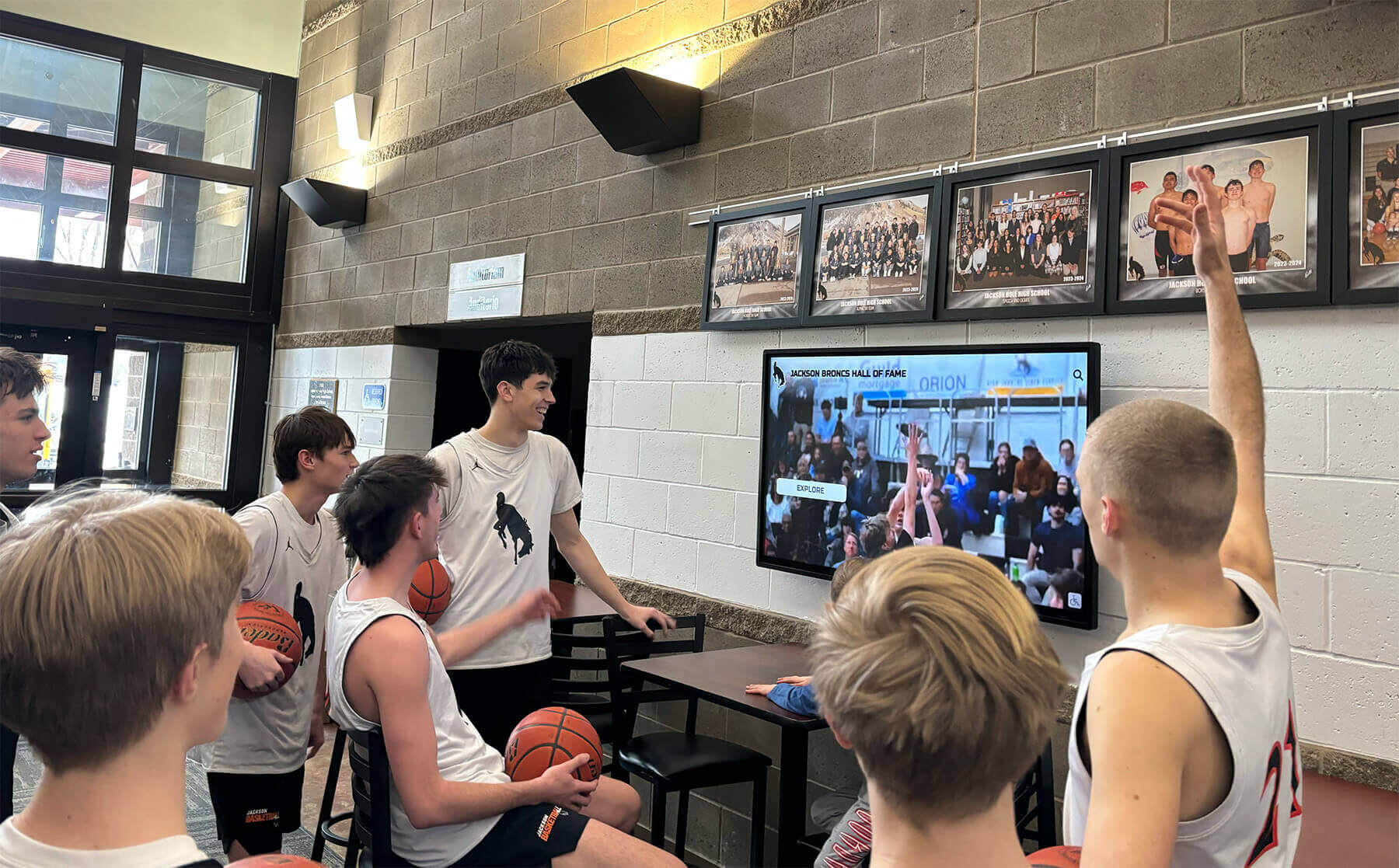School screens don’t have to be boring. Walk into most schools today, and you’ll find displays serving purely functional purposes—lunch menus, announcements, bell schedules. These screens accomplish their administrative objectives but fail to capture student attention or create the engagement that modern technology promises. Students surrounded by interactive smartphones, gaming systems, and social media platforms outside school walls deserve equally compelling experiences inside them.
Fun school screens transform static displays into dynamic, interactive experiences that students genuinely want to engage with. From classroom touchscreens featuring educational games and collaborative activities to hallway displays showcasing student achievements through searchable digital halls of fame, today’s most innovative schools are reimagining what screens can accomplish. These installations don’t just inform—they entertain, motivate, celebrate, and build the vibrant school culture that defines exceptional educational communities.
What Makes a School Screen "Fun"?
Fun school screens share common characteristics: interactivity that invites participation rather than passive viewing, relevant content that connects to student interests and experiences, visual appeal with modern design that matches consumer technology expectations, and purposeful engagement that entertains while supporting educational or community-building objectives. Solutions like Rocket Alumni Solutions specialize in creating recognition displays that students actively seek out, transforming hallway screens from ignored background noise into destinations students visit repeatedly to explore achievements, discover connections, and celebrate excellence.
The Problem with Traditional School Screens
Most school digital displays fail to engage because they operate on outdated broadcast models—pushing information at students rather than inviting interaction. Static announcements change daily, but the format remains predictable and passive. Students glance briefly, absorb relevant information, and move on without genuine engagement or connection to the content.
This missed opportunity becomes particularly apparent when comparing school displays to the technology students interact with everywhere else. Smartphones provide personalized, interactive experiences responding to individual interests. Gaming systems offer immediate feedback and engaging challenges. Social media platforms enable exploration, discovery, and connection. School screens, by contrast, often feel like digital bulletin boards—functional but fundamentally unengaging.
The consequences extend beyond simply wasted display potential. When schools invest in modern screen technology but deploy it in traditional ways, students receive contradictory messages about innovation and engagement. The hardware promises contemporary experiences while the content delivery reflects decades-old broadcast thinking. This disconnect undermines institutional credibility while missing opportunities to leverage technology for building culture, motivating achievement, and strengthening community.
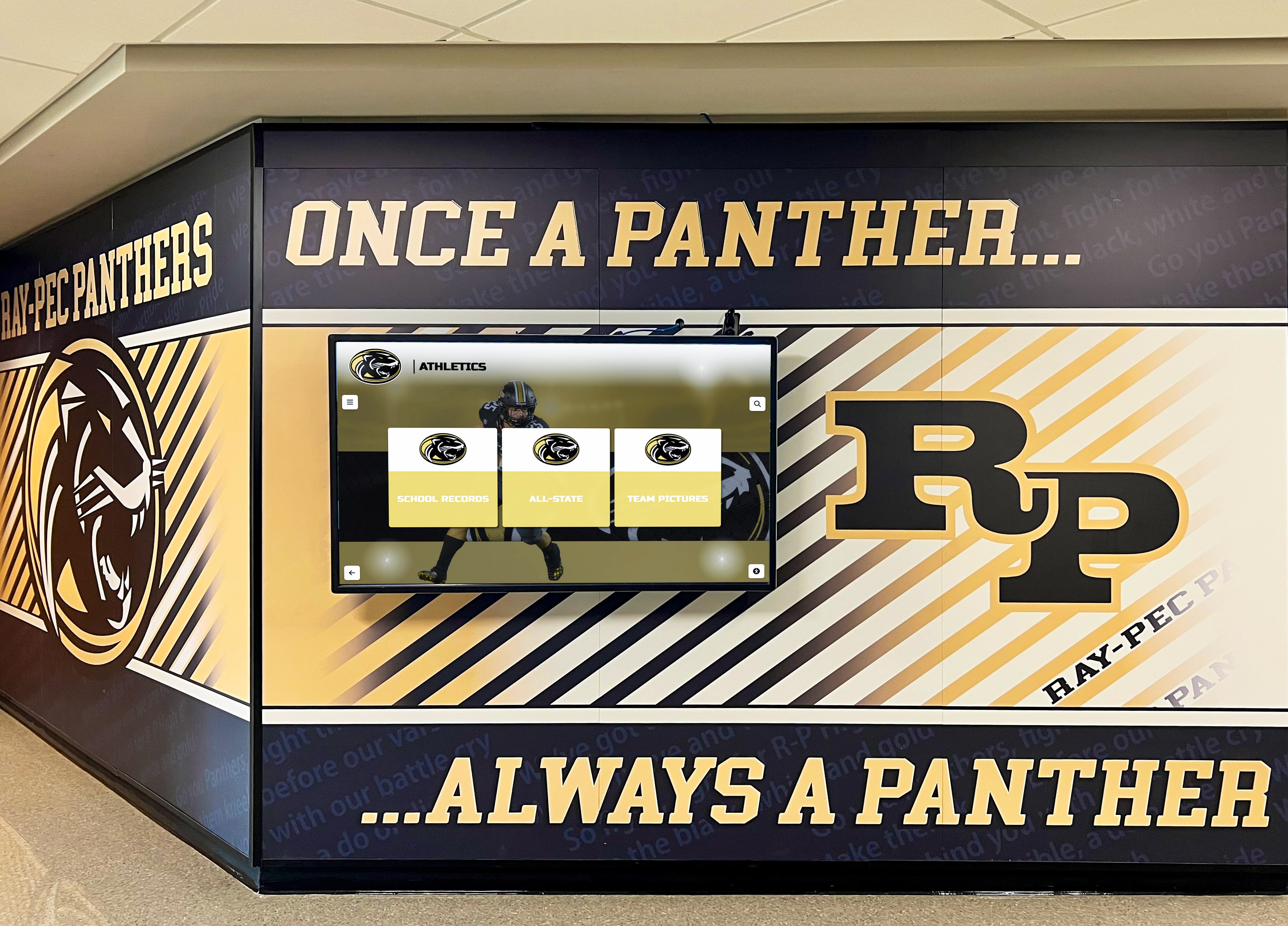
Fun Classroom Screens: Interactive Learning That Engages
Modern classrooms benefit from interactive displays that transform instruction from passive observation to active participation. The best classroom screens don’t just display content—they invite manipulation, enable collaboration, and gamify learning in ways that capture attention while supporting educational objectives.
Educational Games and Interactive Activities
Interactive classroom screens excel when incorporating game-based learning that makes education feel less like work and more like play. These experiences maintain educational rigor while packaging learning in formats students find inherently engaging.
Popular Classroom Screen Games:
Kahoot and Quizizz Integration: Real-time quiz competitions where students answer on personal devices while results display prominently on classroom screens. Leaderboards, countdown timers, and sound effects create excitement around assessment that typically generates anxiety. Teachers report dramatically improved participation when reviewing content through these game formats compared to traditional question-and-answer approaches.
Tic Tac Toe and Classic Games with Educational Twists: Tools like Classroomscreen incorporate familiar games students already know, adapting them for educational purposes. Students must correctly answer review questions to place their X or O, transforming simple entertainment into reinforcement opportunities. The familiar game structure reduces participation anxiety while the competitive element maintains engagement.
Interactive Timelines and Drag-and-Drop Activities: During history lessons, students can manipulate events on touchscreen timelines, physically arranging historical occurrences in proper sequence. This kinesthetic learning approach helps students understand chronology and causation more effectively than simply reading about events. Similarly, science classes use drag-and-drop activities for categorizing organisms, labeling diagrams, or demonstrating processes.
Poll and Survey Widgets: Real-time polling during lessons allows teachers to gauge comprehension instantly while students see their responses contribute to collective class results displayed prominently. This immediate feedback creates accountability while helping teachers identify concepts requiring additional explanation before moving forward.
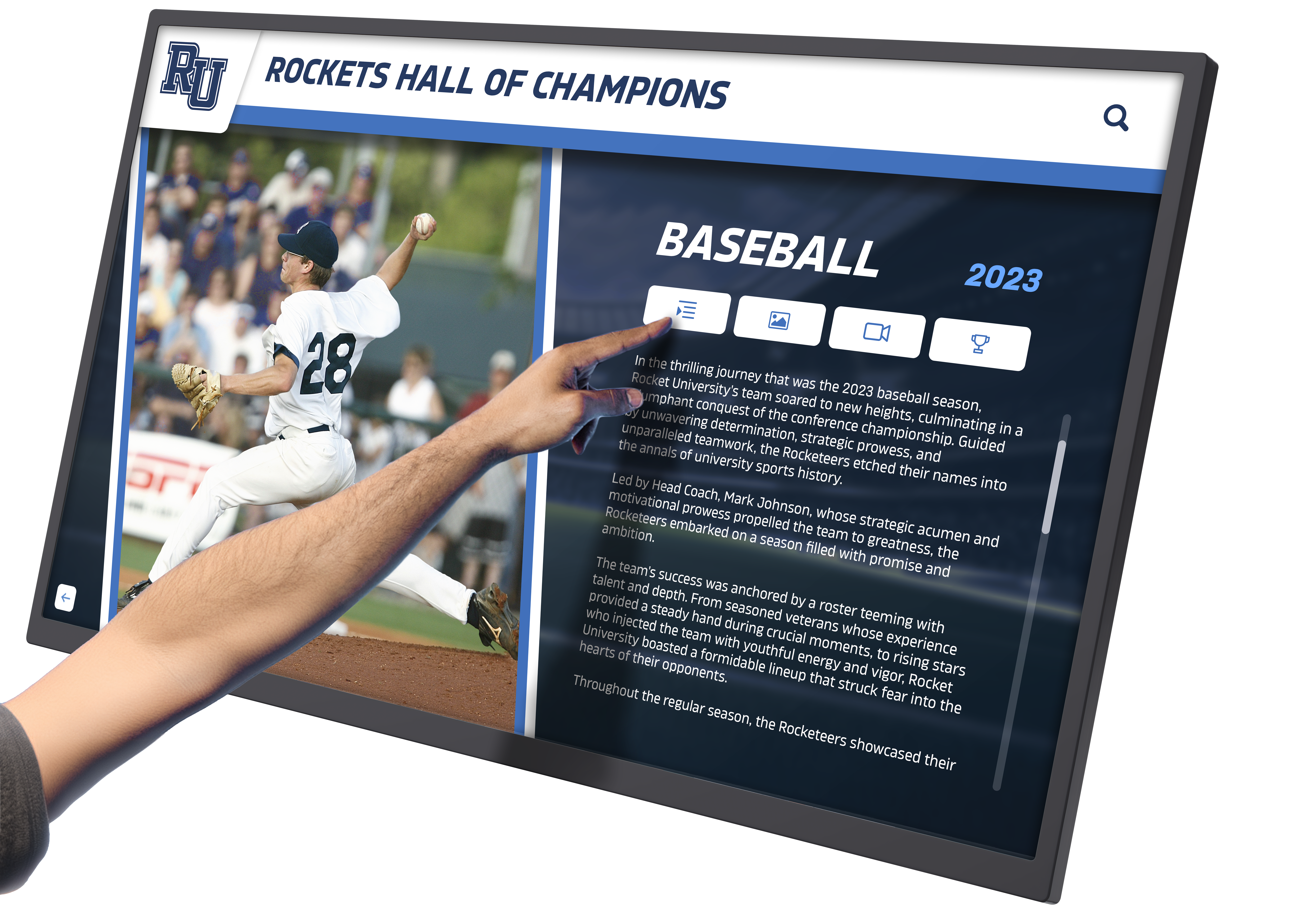
Digital Dice and Random Name Pickers: These simple tools add unpredictability and fairness to classroom activities. Rolling digital dice for math games or using random name pickers for class participation ensures every student has equal opportunities while reducing teacher bias perceptions. The visual display of these selections maintains transparency and builds trust.
Countdown Timers and Progress Visualizations: Visual timers displayed prominently help students manage time during activities while creating urgency that maintains focus. Progress bars showing class advancement toward goals (behavior targets, reading milestones, etc.) provide motivation through visible achievement tracking.
Collaborative Learning Features
Interactive screens transform group work by enabling simultaneous multi-user interaction impossible with traditional teaching tools. Multiple students can work together on single problems, annotate shared documents, or build concept maps collaboratively—all directly on the display.
This simultaneous interaction mirrors how students naturally collaborate while eliminating the awkward turn-taking required with traditional whiteboards. Groups can divide screen space, compare approaches side-by-side, or build on each other’s contributions iteratively. The technology facilitates cooperation rather than merely enabling it.
Teachers implementing collaborative touchscreen activities report increased participation from typically quiet students who feel less performance pressure when contributing alongside peers. The technology reduces individual spotlight anxiety while creating authentic teamwork experiences reflecting real-world collaborative problem-solving.
Multimedia Integration for Multiple Learning Styles
Fun classroom screens accommodate diverse learning preferences through varied content formats. Visual learners engage with high-resolution graphics, color-coded information, and animated demonstrations. Auditory learners benefit from embedded video with narration and recorded explanations they can replay as needed. Kinesthetic learners thrive when physically interacting with screen content through touch, drag, and manipulation.
This multi-modal approach ensures every student finds entry points to understanding regardless of natural learning style. The screen becomes an equalizer—providing multiple pathways to the same learning objectives while maintaining engagement through format variety that prevents predictability and boredom.
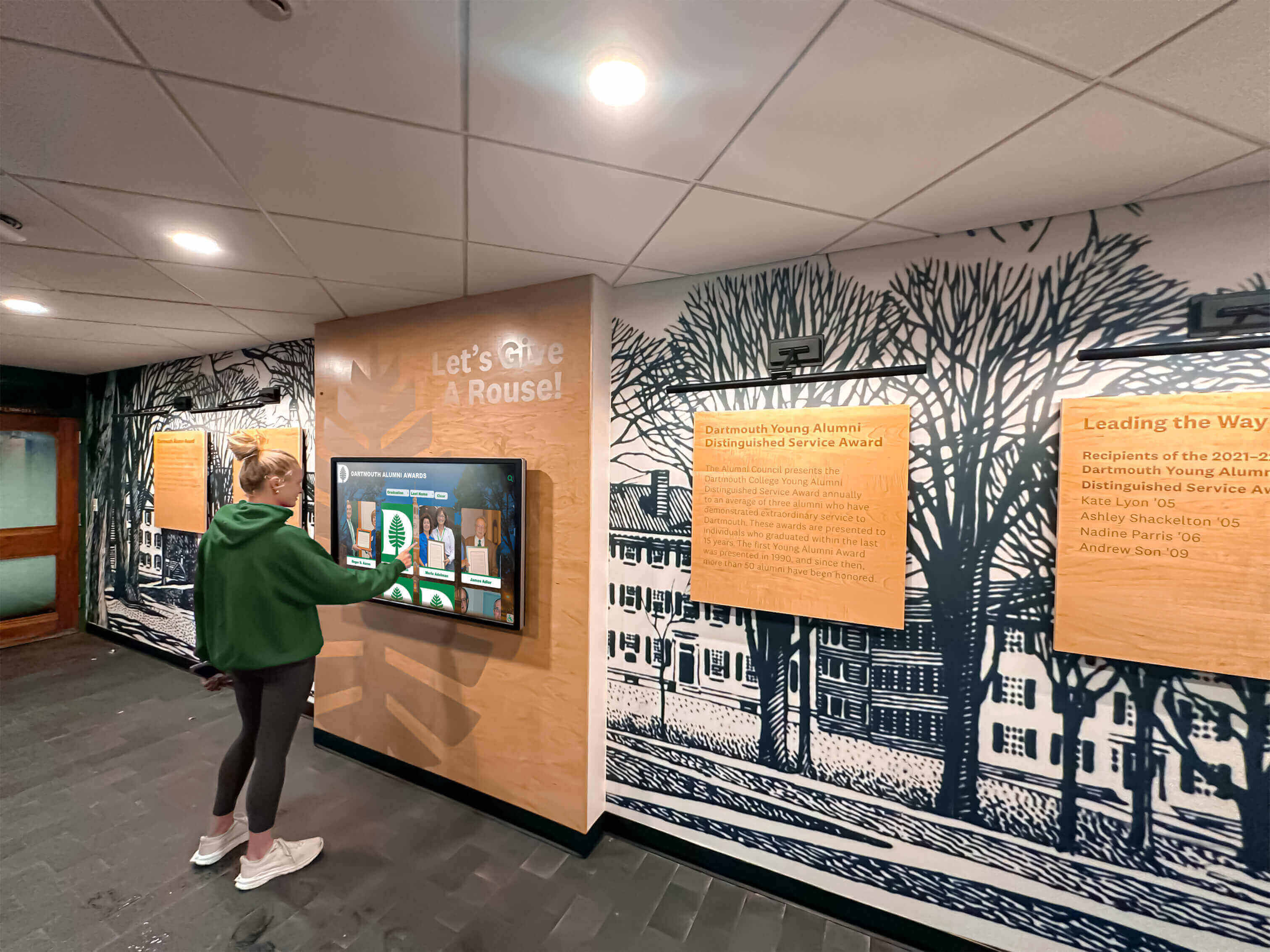
Fun Hallway Screens: Digital Recognition That Builds School Spirit
Beyond classrooms, school hallways and common areas provide ideal locations for screens that build culture, celebrate achievement, and strengthen community. These displays serve fundamentally different purposes than classroom instructional technology—focusing on engagement, inspiration, and connection rather than direct learning objectives.
The Traditional Recognition Problem
Physical trophy cases and static plaque walls face inherent limitations that undermine recognition effectiveness. Space constraints force impossible decisions about which achievements deserve visibility. Recent successes push historical accomplishments into storage where they provide zero inspirational value. Static displays receive brief glances from passersby without enabling the discovery and exploration that create meaningful connections.
More fundamentally, traditional recognition approaches lack the fun factor that captures modern student attention. A wall of identical plaques displaying names and dates feels formal and distant—more museum archive than celebration. Students don’t seek out these displays, return to explore them repeatedly, or share discoveries with friends. Recognition exists but generates minimal engagement beyond those directly honored.
Interactive Recognition Displays: Where Fun Meets Celebration
Digital recognition displays transform achievement celebration from passive viewing to active exploration. Touchscreen interfaces invite interaction. Search capabilities enable students to find personal connections. Multimedia content brings accomplishments to life through photos, videos, and detailed narratives. These displays don’t just inform—they engage, inspire, and entertain.
What Makes Recognition Displays Fun:
Searchability and Personal Discovery: Students love finding themselves, siblings, friends, and relatives in recognition databases. The treasure hunt aspect—searching names, exploring graduation years, browsing sports they participate in—creates engagement impossible with alphabetical plaque lists. This personal relevance transforms recognition from distant history into immediate connection.
When a freshman soccer player discovers her older sister earned all-conference honors three years earlier, that discovery creates motivation and connection far more effectively than noticing a name on a hallway plaque. When students find alumni from their hometowns who pursued similar career interests, these connections inspire possibilities they hadn’t considered. Searchable displays enable these discoveries that static recognition prevents.
Unlimited Capacity Means Comprehensive Recognition: Digital displays eliminate the selective recognition that physical space constraints force. Schools can honor every championship team, every record holder, every academic achievement, every student award—recognizing thousands of accomplishments that dozens of trophy cases could never display.
This unlimited capacity fundamentally changes recognition philosophy. Instead of asking “Who deserves our limited display space?” schools ask “How do we best organize our complete achievement history?” Everyone who earned recognition receives visibility regardless of when achievements occurred or how many others have been honored since. This comprehensive approach demonstrates that schools value all excellence equally.
Solutions like digital recognition displays from Rocket Alumni Solutions provide the unlimited capacity that traditional approaches cannot match, enabling truly comprehensive celebration that honors every deserving student across academics, athletics, arts, service, and character categories.
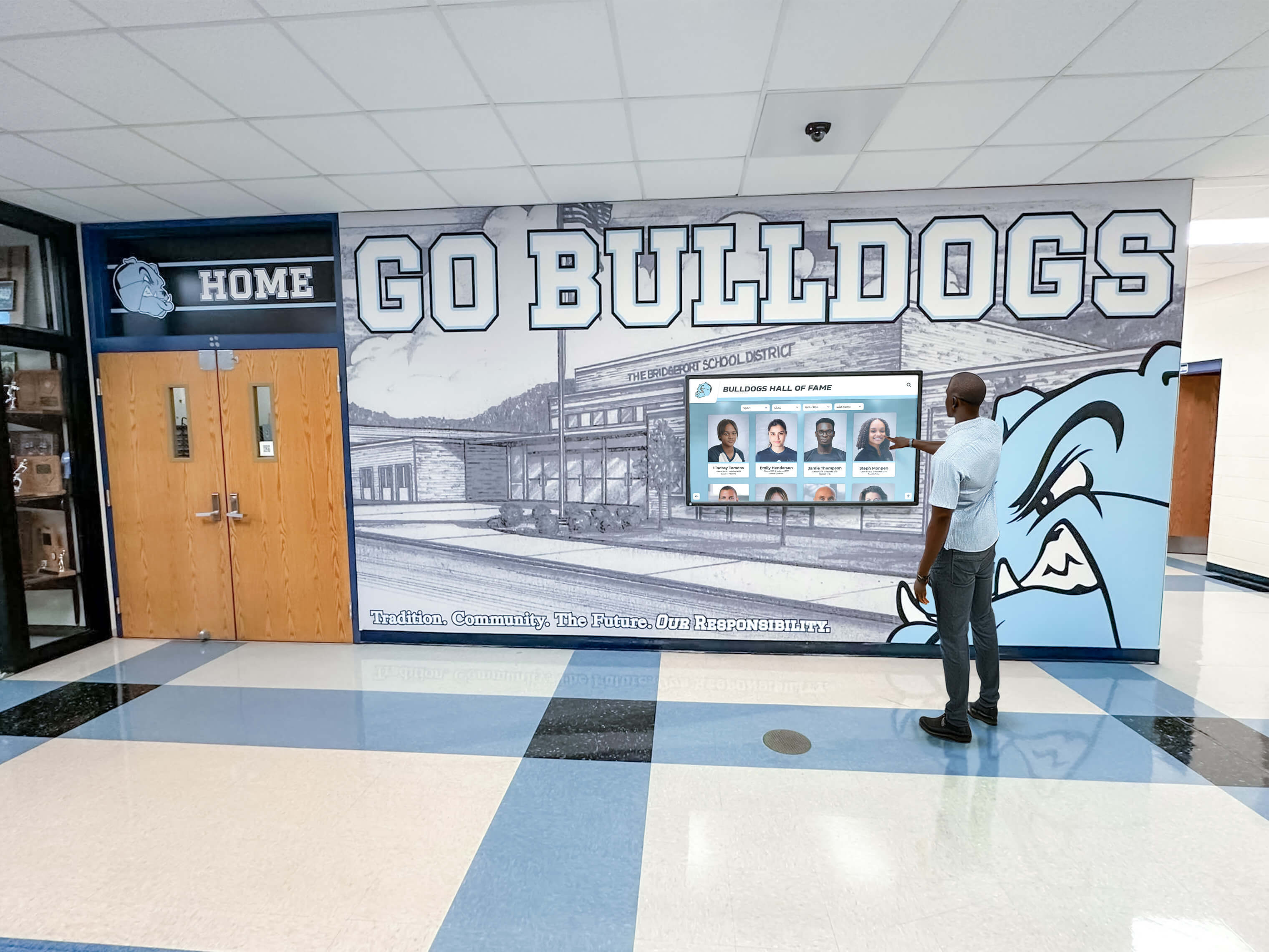
Multimedia Storytelling Makes Achievements Come Alive: Static plaques display minimal information—names, dates, brief statistics. Digital displays support rich multimedia content including high-resolution achievement photography showing students in action, championship game video highlights capturing dramatic moments, detailed narratives explaining achievement significance and context, career statistics and progression over time, and alumni reflections sharing memories and advice for current students.
This storytelling transforms recognition from simple data display into engaging narratives that captivate audiences. Students spend 5-8 minutes exploring well-designed digital recognition compared to 30-60 seconds glancing at traditional trophy cases. This extended engagement creates opportunities for deeper inspiration and more meaningful recognition impact.
Instant Updates Keep Content Fresh: Traditional recognition updates require weeks—designing plaques, processing orders, scheduling installation. Digital recognition updates instantly. After Friday night championships, staff upload photos, enter details, add statistics, and publish updates appearing immediately on displays.
This immediacy ensures recognition happens while achievement excitement remains high. Students see their accomplishments celebrated promptly rather than waiting months for physical plaques. The instant gratification mirrors the immediate feedback students expect from consumer technology while reinforcing achievement significance through timely acknowledgment.
Gamification Elements Add Engagement: Some schools incorporate game-like elements into recognition displays including achievement badges for reaching milestones, leaderboards showing top performers across categories, year-by-year comparisons revealing program growth, record tracking celebrating when new marks are set, and statistical visualizations making data exploration fun rather than dry.
These gamification features add discovery and exploration dimensions that keep students returning to displays repeatedly. Finding who holds records they’re chasing, comparing current team statistics to historical performances, and tracking personal achievement accumulation creates ongoing engagement rather than one-time viewing.
Strategic Placement for Maximum Fun and Impact
Location dramatically affects display engagement and recognition value. The most successful fun school screens occupy positions where students naturally gather, pause, or pass during unstructured time rather than just high-traffic corridors where everyone rushes past.
Commons Areas and Cafeterias: Locations where students spend extended periods during lunch, study halls, or free time provide ideal settings for interactive displays. Students can explore content thoroughly rather than glancing briefly while rushing between classes. These spaces also facilitate social interaction around displays—students showing friends their achievements, groups exploring together, and spontaneous discovery conversations.
Schools implementing recognition displays in commons areas report the highest engagement metrics with average interaction times exceeding 6 minutes compared to 90 seconds in high-traffic hallways. The extended dwell time in these spaces creates opportunities for the deep exploration that builds genuine recognition impact.
Athletic Facilities Near Locker Rooms: Positioning recognition displays where athletes gather before practice, wait for team meetings, or congregate after competitions ensures regular exposure to sports recognition. Current athletes see displays during daily routine, creating aspiration as they envision their own future recognition. The proximity to athletic activity creates natural connections between present effort and future celebration.
Many schools feature recognition displays showing athletic achievements and records prominently in gym lobbies, training facilities, or locker room corridors where athletes spend significant time. This placement maximizes motivational impact while celebrating program traditions and excellence.
Main Building Entrances: Entry locations capture all visitors including prospective families evaluating schools, community members attending events, and daily student traffic. Entry displays establish institutional pride and values immediately while exposing diverse audiences to excellence documentation. These placements make powerful first impressions about school culture and priorities.
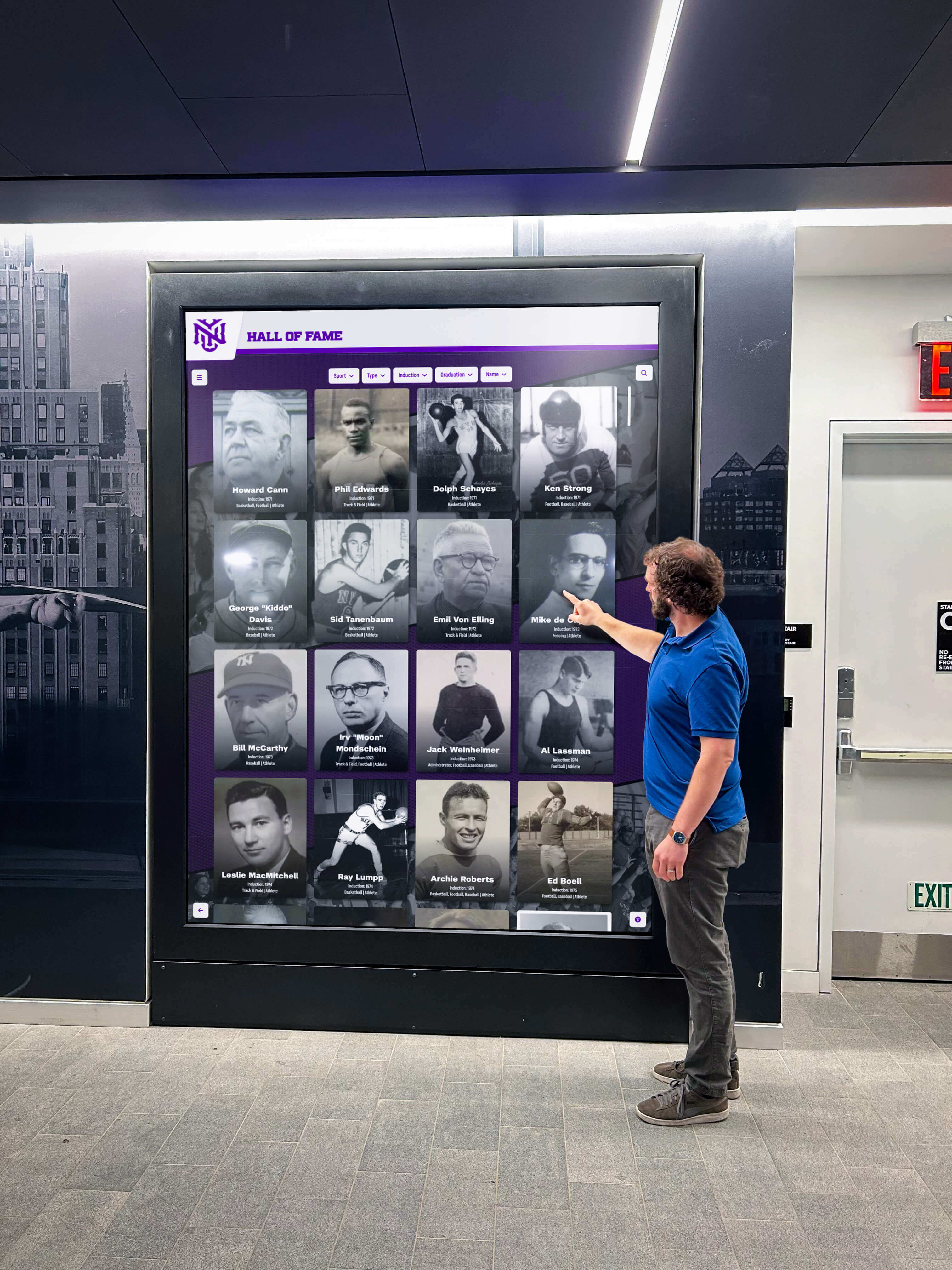
Creating Fun School Screen Content: Best Practices
Effective screen content balances entertainment with purpose, engagement with appropriateness, and fun with educational or community-building objectives.
Content Should Be Interactive, Not Just Informative
The fundamental difference between fun screens and boring ones lies in interaction design. Static information presented on screens feels no more engaging than printed posters. Interactive content inviting participation transforms passive viewers into active participants.
Every screen should answer the question: “What can viewers do with this content beyond simply reading it?” Touchscreens should invite exploration through intuitive navigation. Display content should change based on user input, time of day, or current events. Visual elements should respond to interaction rather than remaining static.
This interaction design thinking separates engaging installations from expensive digital bulletin boards. The technology enables participation—successful implementations leverage that capability rather than ignoring it.
Balance Educational Purpose with Entertainment Value
The most successful school screens serve clear purposes—supporting instruction, celebrating achievement, building community—while packaging those purposes in entertaining formats. Content should align with institutional values and educational objectives rather than pursuing entertainment for its own sake.
Classroom games should reinforce curriculum content while making review engaging. Recognition displays should honor genuine achievement rather than simply entertaining through gimmicks. Hallway screens should communicate important information while presenting it compellingly. This purpose-driven entertainment ensures screens contribute meaningfully to educational missions rather than simply distracting students.
Update Content Regularly to Maintain Interest
Nothing kills engagement faster than stale content. Screens displaying the same information week after week train students to ignore them. Regular updates—new recognition profiles, rotated student spotlights, timely announcements, seasonal themes—signal that content stays current and relevant.
Successful schools establish regular update schedules treating screen content management as ongoing responsibility rather than one-time setup. Recognition displays receive weekly or biweekly additions following competitions and award ceremonies. Classroom screens feature different games and activities across units. Hallway displays rotate featured achievements ensuring variety.
This content freshness maintains the discovery element that makes screens fun. Students check displays expecting to find new information rather than ignoring them because nothing ever changes.
Design for Mobile and Multi-Platform Access
Fun doesn’t stop at physical displays. The most engaging school screens extend beyond single locations through mobile apps, web access, and social sharing. Students can explore recognition from smartphones, share achievements with families through social media, and access content from anywhere rather than requiring physical campus visits.
This multi-platform approach particularly benefits alumni, families, and remote community members who want to engage with school achievement but cannot visit campus regularly. Mobile accessibility ensures recognition reaches broader audiences while providing convenient exploration options matching how people naturally consume content today.
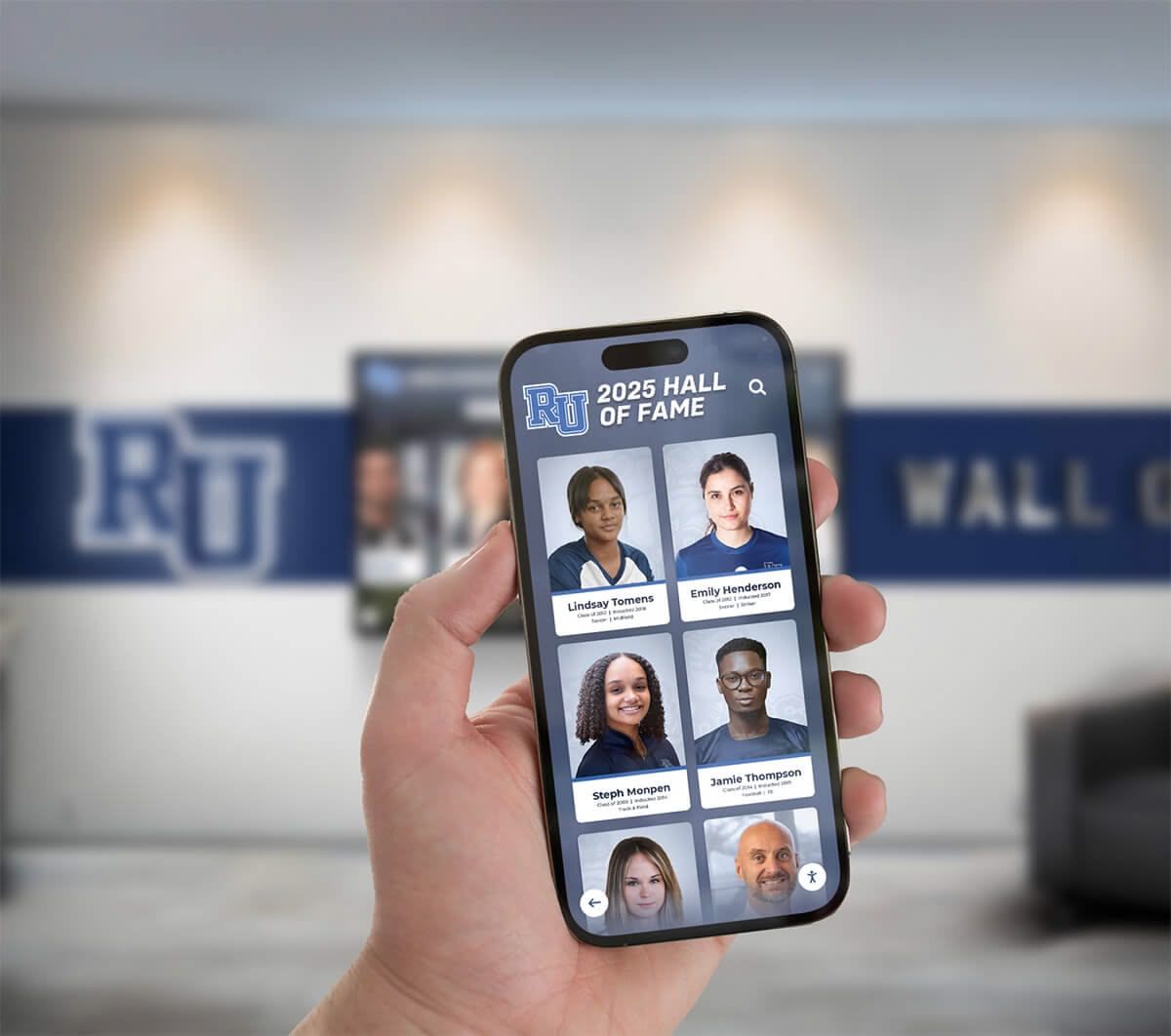
Technology Requirements for Fun School Screens
Creating truly engaging displays requires appropriate technology supporting interactivity, multimedia content, and reliable performance.
Touchscreen Displays for Hallway Recognition
Interactive recognition displays benefit from commercial-grade touchscreens designed for continuous public operation. These displays feature durable tempered glass resisting heavy use, responsive touch technology supporting intuitive interaction, appropriate sizing (typically 43-75 inches) for hallway viewing distances, and network connectivity enabling cloud-based content management.
Commercial displays differ fundamentally from consumer TVs through construction quality, operational ratings (50,000-70,000 continuous hours), and support for interactive software platforms. While consumer displays might seem financially appealing, they lack the durability and reliability that public school installations require.
Screen size should match viewing distance and audience size. Smaller 43-55 inch displays suit locations with close individual interaction. Larger 65-75 inch screens work better for high-traffic areas or group viewing situations where multiple students explore together.
Purpose-Built Recognition Software
Hardware alone doesn’t create engaging recognition displays—specialized software designed specifically for showcasing achievements makes the difference. Generic digital signage platforms lack features schools need for managing extensive recognition content, organizing achievements across categories, enabling intuitive search and discovery, supporting multimedia profiles with photos and video, and providing analytics revealing engagement patterns.
Rocket Alumni Solutions provides purpose-built recognition platforms specifically designed for educational institutions. These systems feature intuitive content management requiring no technical expertise, professional presentation templates ensuring consistent quality, powerful search capabilities enabling personal discovery, cloud-based architecture supporting remote management, and mobile accessibility extending reach beyond physical displays.
This specialized software transforms generic touchscreens into powerful recognition systems specifically designed for the unique needs educational institutions face when celebrating achievement comprehensively.
Network Infrastructure and Support
Interactive displays require reliable network connectivity supporting content delivery, cloud platform communication, and software updates. Hardwired Ethernet connections provide superior reliability compared to wireless networking, though high-quality WiFi networks may suffice in some locations.
Schools should ensure adequate network capacity for simultaneous display use, reliable connectivity in all installation locations, appropriate security policies allowing necessary access, and content delivery optimization for smooth video playback.
IT departments should be involved early in planning processes ensuring infrastructure exists or can be installed before display deployment. This upfront coordination prevents frustrating connectivity issues undermining display effectiveness.
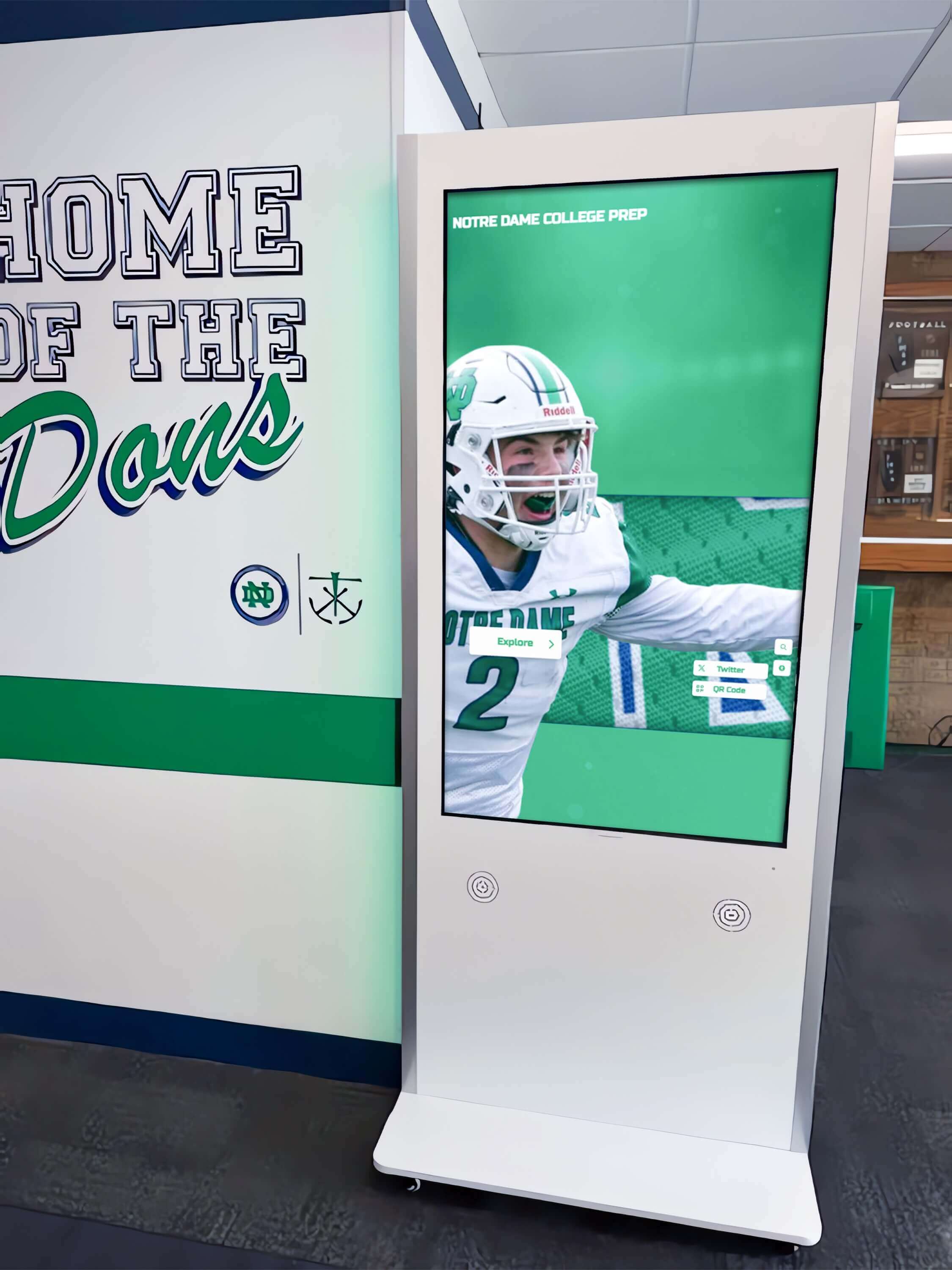
Real-World Fun School Screen Applications
Schools successfully implementing engaging displays share common strategies and approaches worth examining.
Interactive Recognition Walls Celebrating All Achievement
Many schools now feature comprehensive digital halls of fame showcasing unlimited student achievements across academics, athletics, arts, service, and character. These installations replace traditional trophy cases and plaque walls with searchable, interactive displays students actually seek out and explore repeatedly.
For example, schools implementing touchscreen halls of fame report average interaction times exceeding 6 minutes compared to brief glances at traditional trophy cases. Students search their own names, explore siblings’ and friends’ achievements, browse sports they participate in, and discover alumni who pursued similar interests or careers.
This personal relevance makes recognition fun rather than formal. Students return to displays repeatedly discovering new connections and exploring different achievement categories. Recognition becomes destination rather than background, engagement rather than obligation.
Student Spotlight Displays Rotating Featured Achievers
Some schools feature rotating student spotlight displays highlighting different achievers weekly or monthly. These features include student photos and achievement details, video interviews where students share experiences and advice, connections to longer recognition profiles for deeper exploration, and social sharing options extending visibility beyond campus.
These spotlight features create ongoing interest as students check displays anticipating who will be featured next. The rotation ensures comprehensive recognition over time while maintaining freshness that static displays cannot achieve.
Interactive School History Timelines
Digital timeline displays documenting institutional history create engaging exploration of school heritage. Students can browse chronologically through decades, filter by achievement type (athletics, academics, facilities, notable alumni), view period-appropriate photos and videos, and understand program evolution and tradition development.
These timelines transform school history from dusty archives into accessible narratives connecting current students to institutional legacies. Understanding program histories, traditions, and notable alumni creates pride and connection that strengthen school culture. Schools seeking to preserve and showcase institutional history find interactive timelines accomplish these goals while maintaining student engagement.
Game-Based Learning Displays in Media Centers
School libraries and media centers increasingly feature interactive displays with educational games, reading challenges with progress visualization, book recommendations based on student interests, and author information and multimedia content.
These installations transform media centers from quiet study halls into dynamic learning environments where students actively engage with literary content rather than simply checking out books. The game elements and interactive discovery make reading promotion feel fun rather than obligatory.
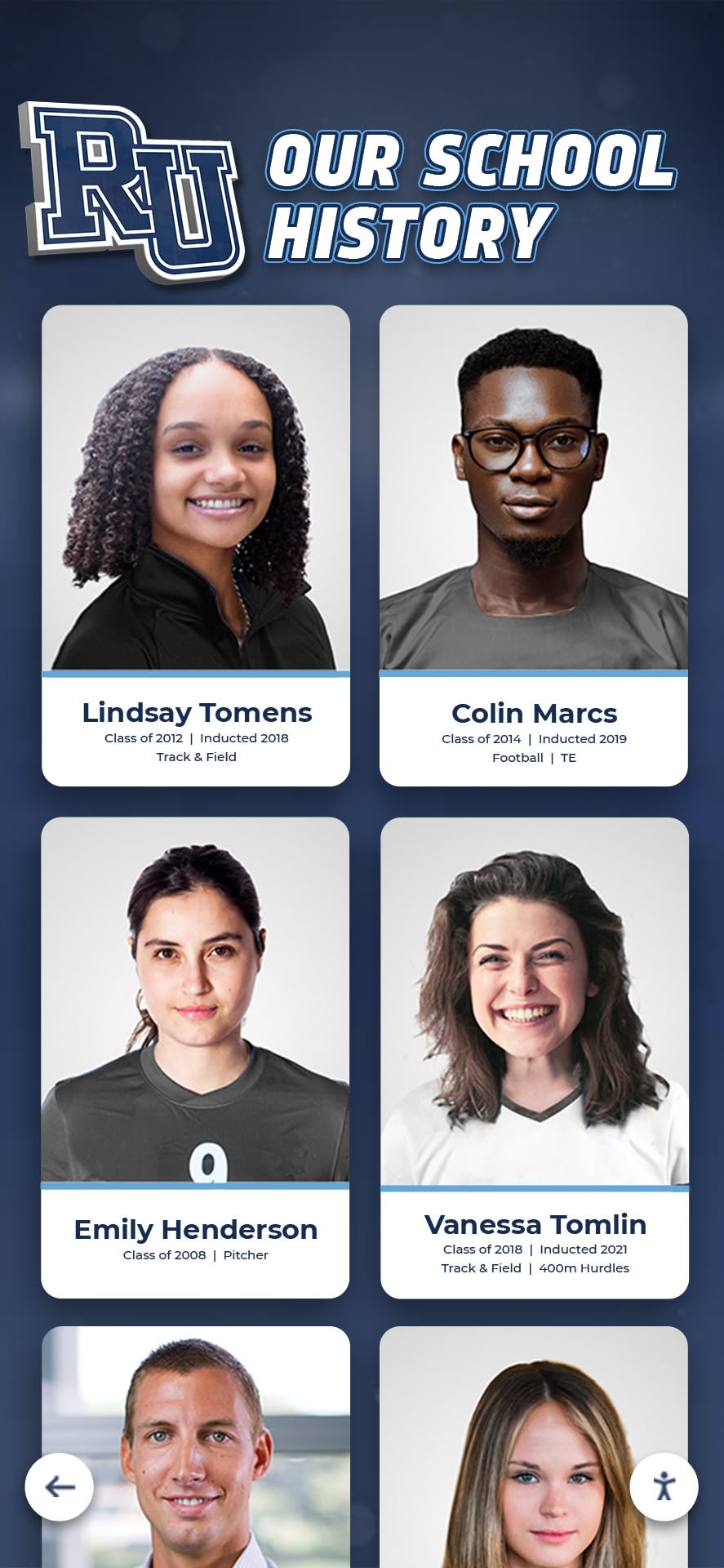
Common Challenges and Solutions
Schools implementing fun screen strategies encounter predictable obstacles with established solutions.
Challenge: Content Creation Burden Seems Overwhelming
Creating extensive recognition content for digital displays feels daunting, particularly when schools have decades of achievement to document. The prospect of photographing thousands of trophies, gathering achievement details, and entering comprehensive data overwhelms many schools before they start.
Solution: Implement phased content development beginning with recent, well-documented achievements from the past 5-10 years. Launch displays with this priority content providing immediate value while establishing manageable processes for ongoing additions. Systematically expand historical coverage as time permits rather than delaying implementation until complete archives exist.
Many schools engage students in content development as authentic learning opportunities. Photography students create achievement portraits, journalism students write profiles, digital media students produce video content, and history students research historical accomplishments. This approach reduces staff burden while providing valuable educational experiences.
Challenge: Ensuring Equitable Recognition Across All Students
Digital recognition capacity eliminates physical space limitations, but schools must intentionally ensure comprehensive recognition spanning diverse achievement types and student populations. Without deliberate attention to equity, recognition might inadvertently favor particular programs, demographics, or achievement categories.
Solution: Establish explicit recognition categories spanning academics, athletics, arts, service, and character. Monitor recognition distribution across demographics, programs, and achievement types. Implement proactive nomination processes seeking deserving students in underrecognized categories rather than waiting for nominations to arrive organically.
Inclusive recognition programs like those exploring student awards and achievement celebration ensure all students experience meaningful acknowledgment validating their contributions regardless of which forms excellence takes.
Challenge: Maintaining Student Interest Over Time
Initial excitement about new displays naturally wanes as novelty fades. Without intentional engagement strategies, even interactive displays risk becoming background noise students learn to ignore.
Solution: Regular content updates maintain freshness and discovery opportunities. Feature rotating student spotlights, seasonal content themes, timely achievement additions following competitions, and periodic interface updates introducing new features or navigation approaches.
Analytics tracking engagement patterns reveal which content resonates and when interest may be declining. This data informs content strategy adjustments ensuring displays remain engaging long-term rather than becoming ignored installations.
Challenge: Limited Budget for Multiple Displays
Comprehensive screen deployment throughout facilities requires investment many schools struggle to allocate. Single display purchases may fit budgets while comprehensive coverage exceeds available funding.
Solution: Prioritize strategic initial placements in high-impact locations—main building entrances, commons areas, or athletic facilities—demonstrating value before expanding to additional locations. Phase expansion over multiple years as budget permits rather than attempting complete deployment immediately.
Explore diverse funding sources including technology budgets, booster club support, alumni giving campaigns, corporate sponsorships, and facilities improvement bonds. Recognition displays create natural fundraising opportunities with donor acknowledgment incorporated into recognition content.
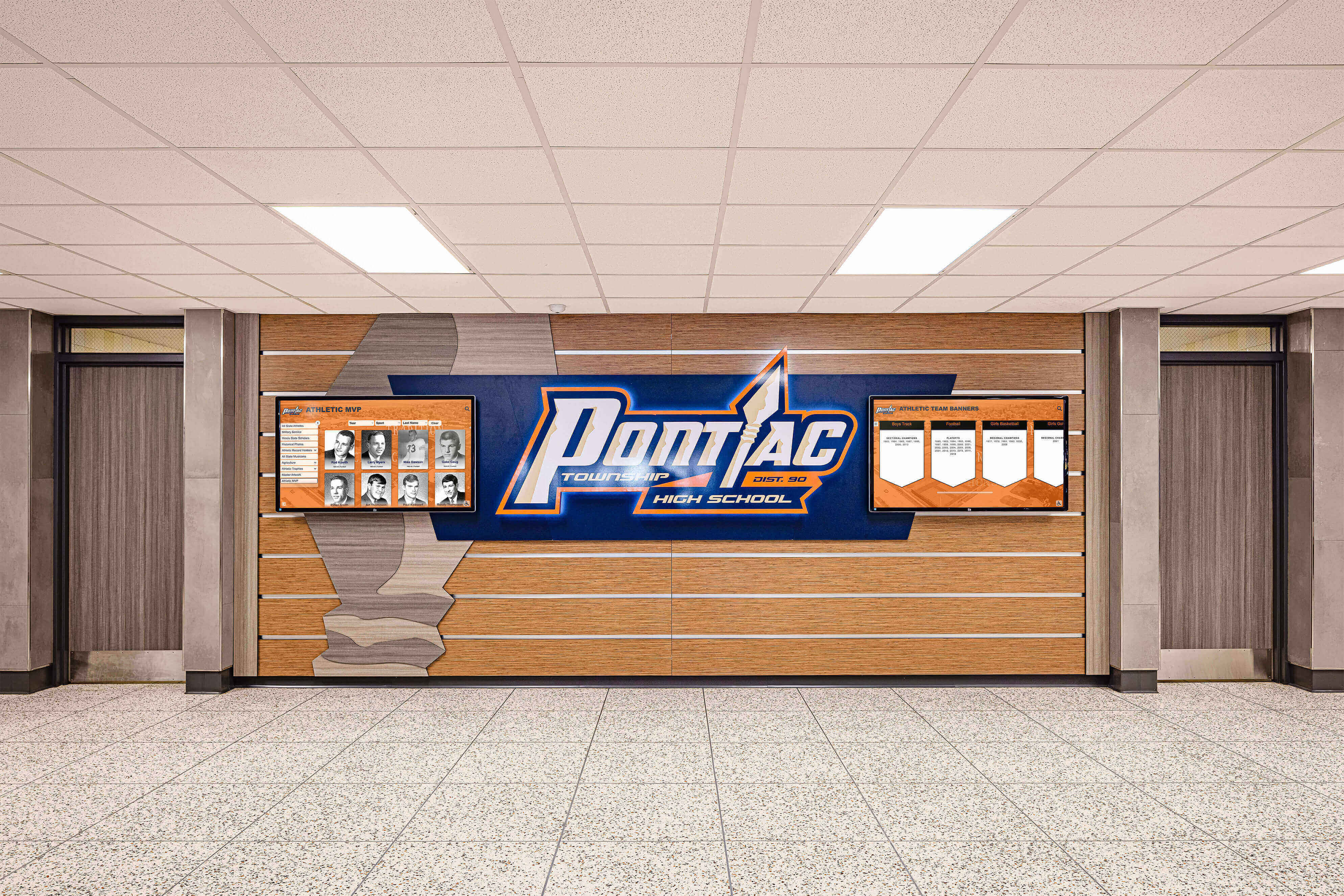
The Future of Fun School Screens
Emerging technologies promise even more engaging interactive display experiences in coming years.
Artificial Intelligence and Personalization
AI capabilities will enable personalized content recommendations based on viewer interests, natural language search understanding conversational queries, automated content suggestions based on viewing patterns, and voice interaction supporting hands-free exploration.
These enhancements make displays feel responsive and intuitive—adapting to individual preferences rather than presenting identical experiences to all viewers. Personalization increases relevance and engagement by surfacing content aligned with each student’s interests and connections.
Augmented Reality Integration
AR features may overlay digital content on physical spaces, provide immersive achievement experiences through smartphone apps, create virtual tours of school history and accomplishments, and connect physical trophies to rich digital context through device cameras.
This blending of physical and digital recognition combines traditional trophy case tangibility with digital capability and capacity. Students might scan physical displays with smartphones revealing additional content, videos, and interactive features impossible in purely physical installations.
Enhanced Social Integration
Future displays will seamlessly integrate with social media platforms enabling easy sharing, connect with advancement databases creating unified engagement systems, support video messaging and alumni testimonials, and facilitate mentorship connections between current students and alumni.
This integration extends recognition beyond campus walls while strengthening alumni connections and engagement. Digital displays become hubs for ongoing community interaction rather than one-way celebration channels.
Creating Your Fun School Screen Strategy
Schools ready to transform displays from functional to engaging should follow systematic implementation approaches.
Step 1 - Define Objectives and Priorities: Determine what screens should accomplish—supporting instruction, building culture, celebrating achievement, improving communication. Clear objectives inform technology selection and content strategy decisions.
Step 2 - Assess Current Technology and Infrastructure: Inventory existing displays, evaluate capabilities and limitations, assess network infrastructure adequacy, and identify gaps between current state and objectives.
Step 3 - Select Appropriate Technology and Partners: Research available platforms and solutions, request demonstrations from potential vendors, check references from similar schools, evaluate features, support, and long-term viability, and select partners aligned with institutional needs and budgets.
Step 4 - Develop Content Strategy and Creation Processes: Plan initial content and systematic expansion, establish update responsibilities and schedules, develop creation workflows and quality standards, and engage stakeholders including students, staff, and community members.
Step 5 - Implement, Launch, and Refine: Complete installation and technical configuration, conduct soft launch testing and refinement, host grand opening generating awareness and excitement, gather feedback and engagement data, and continuously improve based on evidence and stakeholder input.
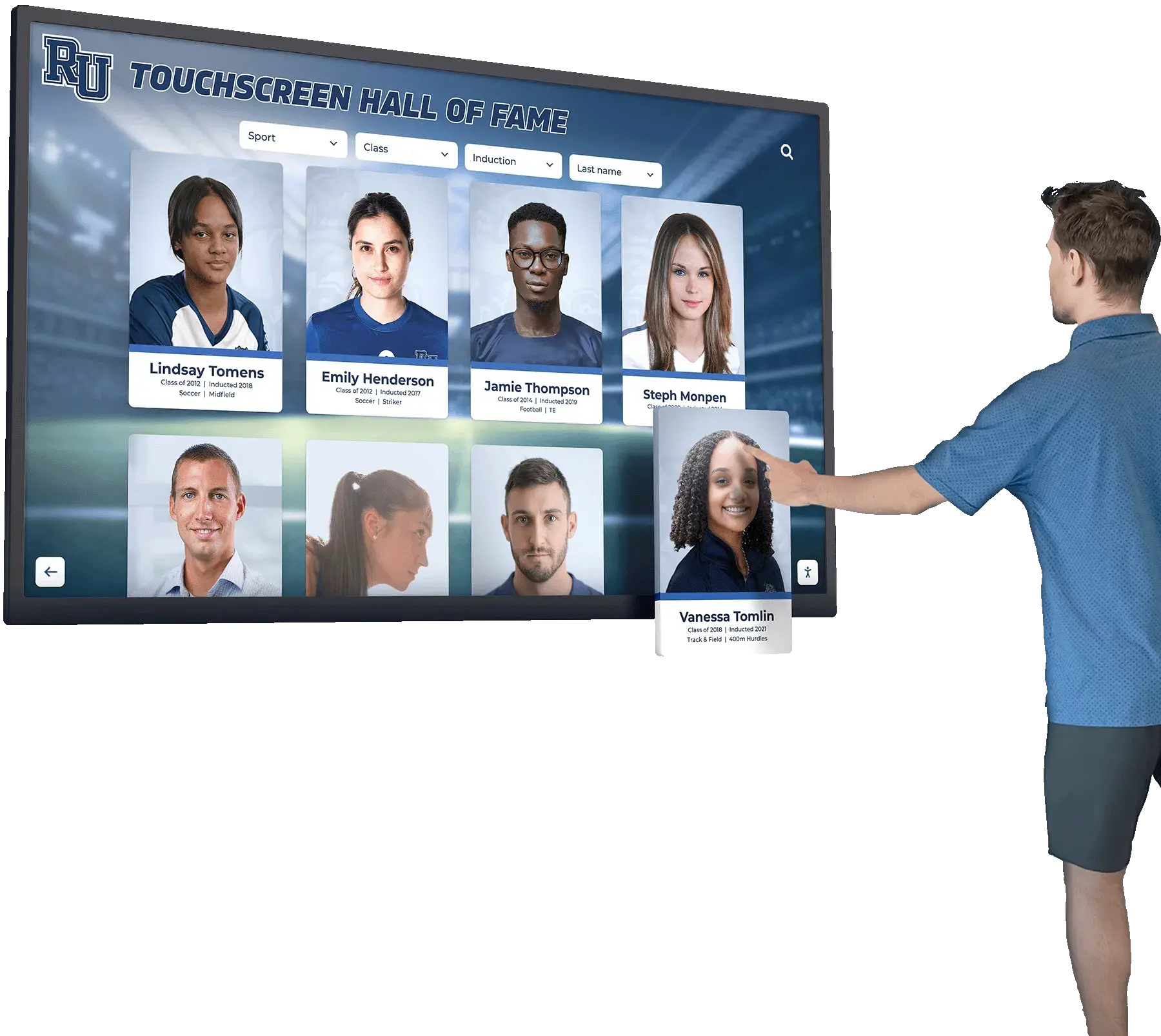
Making School Screens Actually Fun: Key Takeaways
Transforming school displays from ignored background elements to engaging destinations students actively seek out requires intentional design focused on interactivity, relevance, and purpose. The most successful implementations combine appropriate technology with strategic content creation and ongoing management maintaining freshness and engagement.
In classrooms, interactive screens transform passive instruction into active participation through educational games, collaborative activities, and multimedia content accommodating diverse learning styles. These installations make learning more engaging while supporting rigorous academic objectives.
In hallways and common areas, recognition displays celebrating student achievement build school culture and community when designed for exploration rather than passive viewing. Searchability enabling personal discovery, unlimited capacity honoring all achievement, multimedia storytelling bringing accomplishments to life, and instant updates maintaining freshness create recognition experiences students find genuinely compelling.
The technology enabling these experiences—commercial-grade touchscreens, purpose-built recognition software, reliable network infrastructure—provides the foundation. The content and interaction design determine whether investments deliver engaging experiences or simply expensive digital bulletin boards.
Schools implementing fun screen strategies report measurable benefits including increased student engagement and participation, improved school culture and community connections, enhanced recognition of diverse achievements, stronger alumni relationships and support, and more effective use of technology investments.
Whether starting with classroom interactive panels, hallway recognition displays, or comprehensive strategies addressing both applications, schools should prioritize ease of use ensuring adoption, regular content updates maintaining relevance, strategic placement maximizing exposure and engagement, and purpose-driven design aligning entertainment with educational objectives.
Every screen represents opportunity—to engage students differently, celebrate achievement comprehensively, build culture authentically, and leverage technology purposefully. The question isn’t whether schools should deploy interactive displays, but rather how to implement them in ways that students find genuinely fun, engaging, and valuable.
Ready to transform your school’s displays into engaging recognition systems students actually love? Explore how Rocket Alumni Solutions provides purpose-built platforms specifically designed for school recognition, combining intuitive management with fun, interactive experiences that celebrate achievement while building lasting school pride and community.
